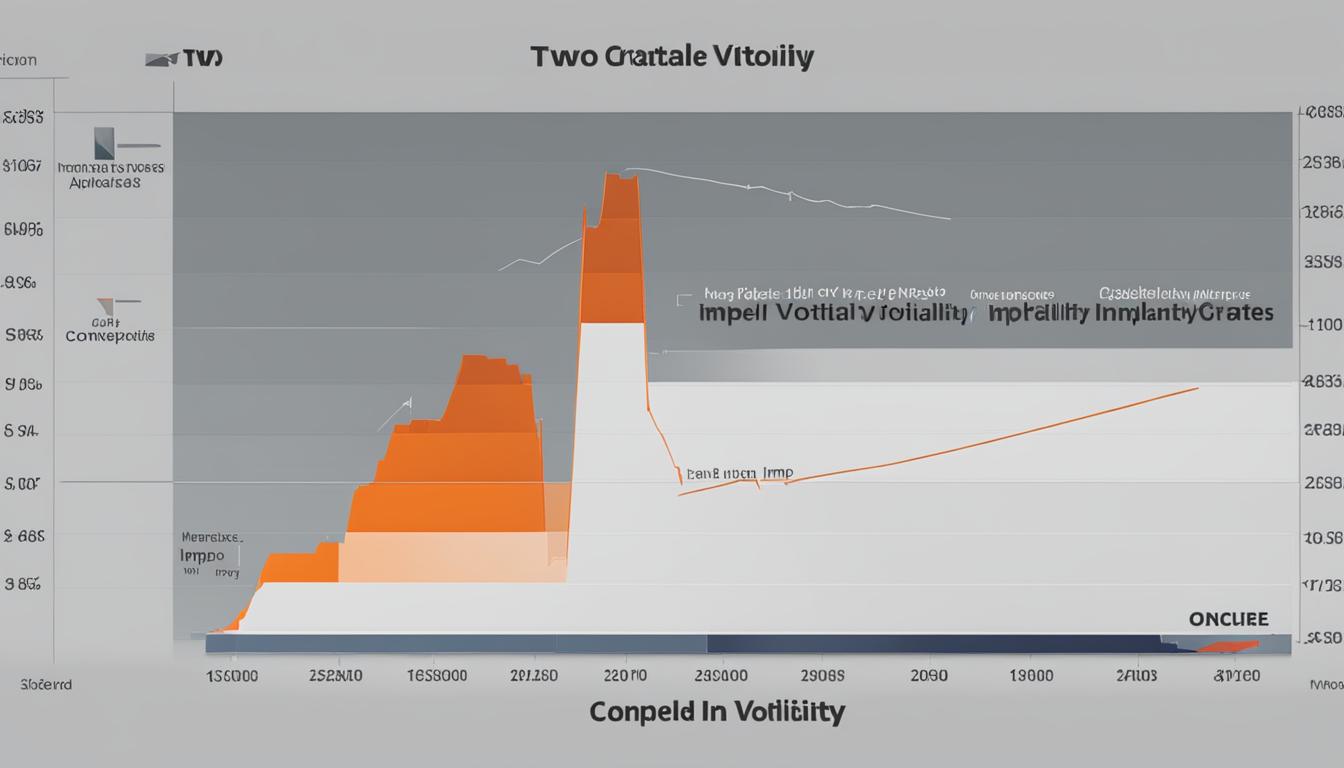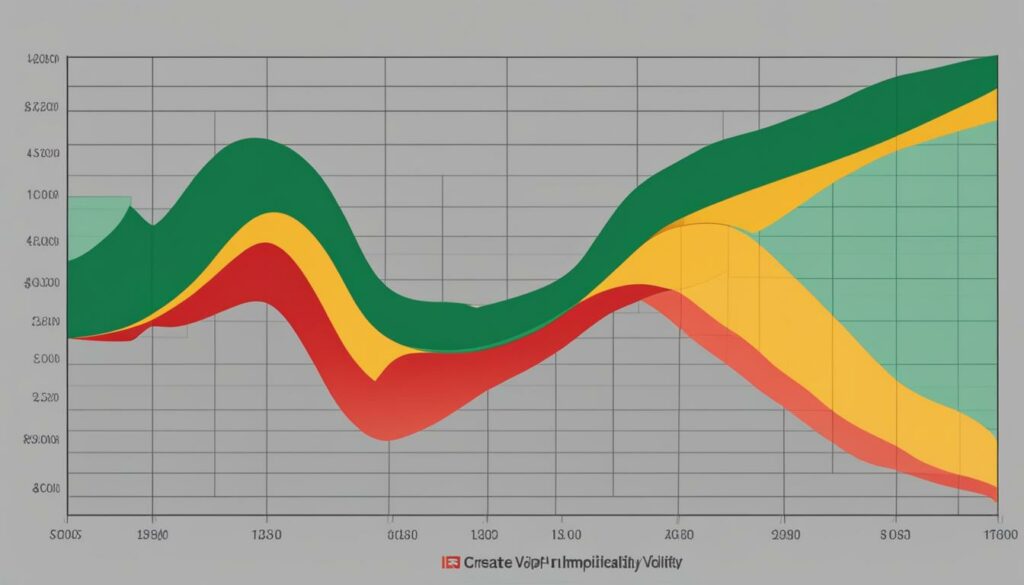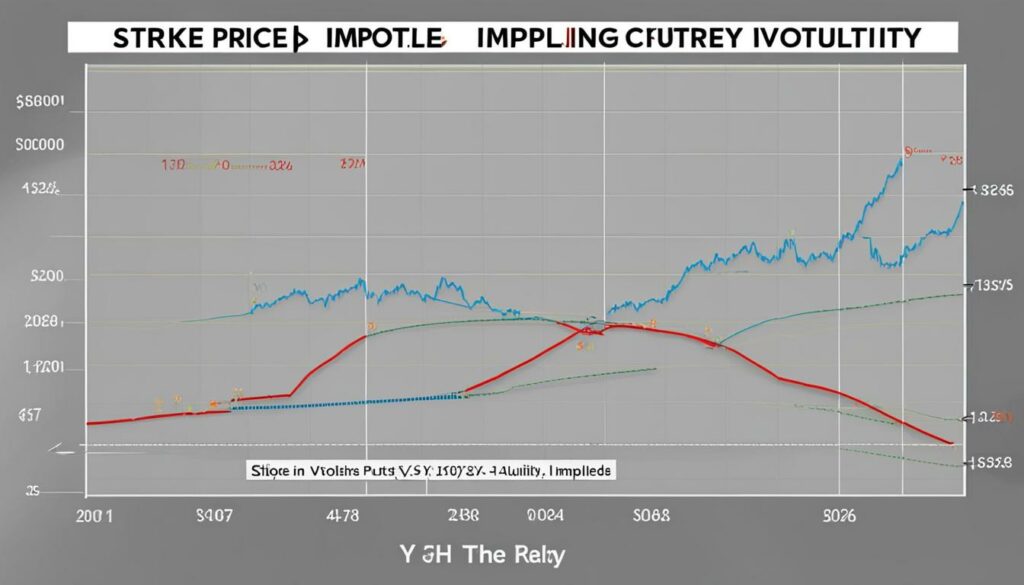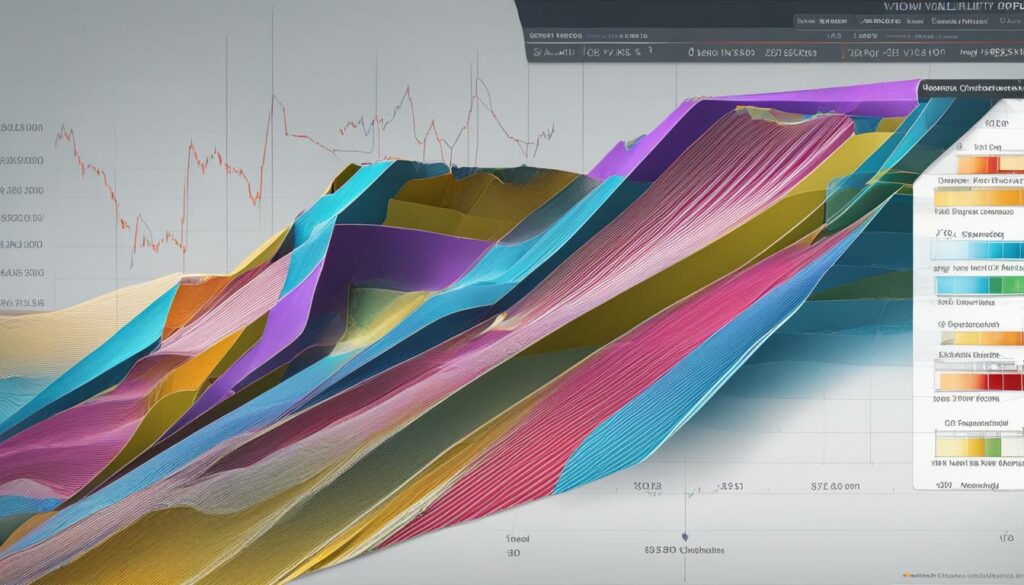Volatility Skew: Understanding Why Options Have Different Implied Volatility

Options trading involves a complex interplay of various factors, one of which is implied volatility. But why do options with the same expiration date exhibit different implied volatilities? The answer lies in understanding the concept of volatility skew. By examining the shape and patterns of implied volatilities across various strike prices, we can gain valuable insights into market sentiment and potential opportunities for options trading.
The volatility skew, also known as the volatility smile, refers to the graphical representation of implied volatilities for options at different strike prices. It reveals a skew or smile-shaped curve, indicating that options further out of the money tend to have higher implied volatility values. This skewness in implied volatility reflects the market’s perception of future volatility and provides important information for options traders.
Implied volatility, derived from an option’s price, represents the market’s expectation of the underlying asset’s future price fluctuations. It does not predict the direction of price movement but rather quantifies the market’s belief about the potential magnitude of future volatility. This information is particularly useful for risk management and option pricing.
Key Takeaways:
- Volatility skew shows the shape of implied volatilities for options across different strike prices.
- Options further out of the money tend to have higher implied volatility values.
- Implied volatility represents the market’s expectation of future price fluctuations.
- Volatility skew provides insights into market sentiment and can help identify potential trading opportunities.
- Understanding volatility skew is crucial for risk management and option pricing.
Implied Volatility: Estimating Future Price Fluctuations
Implied volatility plays a crucial role in estimating future price fluctuations in options trading. It is an estimate of the volatility of an underlying asset between the present moment and the expiration of an options contract. Derived from the option’s price, implied volatility is one of the key inputs in option pricing models. Higher implied volatilities result in higher option prices, reflecting the market’s perception of future volatility. However, it’s important to note that implied volatility does not indicate the direction of price movement, but rather the market’s expectation of potential price swings.
Traders and investors utilize implied volatility as a risk management tool. By assessing the market’s perception of future volatility, they can better understand and manage the potential risks associated with a particular security or asset. Implied volatility can help traders evaluate the potential profitability and risk of a trade, allowing them to adjust their position sizing and strategies accordingly. It is especially useful for options traders who heavily rely on volatility for their trading decisions.

To gain a deeper understanding of implied volatility, traders often analyze historical volatility, implied volatility levels, and the volatility skew. Historical volatility provides insights into past price fluctuations, while implied volatility reflects the market’s expectation of future volatility. The volatility skew, on the other hand, refers to the shape of implied volatilities across different strike prices. By studying these factors, traders can make informed decisions based on their outlook for future price movements.
Implied Volatility and Option Pricing
Option pricing models, such as the Black-Scholes model, incorporate implied volatility to price options accurately. Implied volatility captures the market’s expectation of potential price movements and adjusts the option pricing accordingly. A higher implied volatility leads to higher option prices due to the increased perceived risk. Conversely, a lower implied volatility results in lower option prices as the market expects less price volatility in the future. By considering implied volatility in option pricing, traders can assess whether options are overpriced or underpriced, providing opportunities for potential trading strategies.
Understanding Volatility Skew: Types and Interpretation
The volatility skew is a phenomenon observed in options markets where implied volatility levels differ for options with different strike prices but the same expiration date. It provides valuable insights into market sentiment and can help investors make informed trading decisions based on the expected direction of price movement. There are two main types of volatility skew: forward skew and reverse skew.
Forward Skew
A forward skew is characterized by higher implied volatility at higher strike prices. This type of skew is commonly seen in commodity markets where a decrease in supply can lead to a rapid increase in prices. Investors expect a potential price increase in the underlying asset and are willing to pay a higher premium for call options with higher strike prices.
Reverse Skew
A reverse skew is characterized by higher implied volatility at lower strike prices. This type of skew is often observed in index options and reflects the market’s expectation of a large price decline. Investors are willing to pay a higher premium for put options with lower strike prices as a form of protection against potential market downturns.
Understanding the volatility skew is crucial for options traders as it can help identify mispriced options and uncover potential trading opportunities. By analyzing the shape and slope of the volatility skew, traders can determine the relative pricing of options with different strike prices and adjust their trading strategies accordingly.

Table: Volatility Skew Examples
| Strike Price | Implied Volatility (Forward Skew) | Implied Volatility (Reverse Skew) |
|---|---|---|
| 100 | 20% | 30% |
| 110 | 22% | 28% |
| 120 | 25% | 25% |
| 130 | 28% | 22% |
| 140 | 30% | 20% |
The table above illustrates examples of volatility skew for both forward and reverse skews. In a forward skew, the implied volatility increases as the strike price increases, indicating a bullish sentiment. In a reverse skew, the implied volatility is higher for lower strike prices, suggesting a bearish sentiment. Traders can analyze these volatility skew patterns to identify potential trading opportunities and adjust their strategies accordingly.
Analyzing Volatility Skew for Trading Strategies
Volatility skew can be a valuable tool for options traders looking to develop effective trading strategies. By analyzing the shape and slope of the volatility skew, traders can gain insights into the relative pricing of options with different strike prices. This can help identify potential mispricing and create opportunities for profitable trades.
One trading strategy that can be employed is to look for significant differences in implied volatility between out-of-the-money and at-the-money options. When the implied volatility is considerably higher for out-of-the-money options, it may indicate that the market is pricing in a higher probability of a large price movement in the near future. In such cases, a trader might consider implementing a vertical spread strategy, which involves buying and selling options with different strike prices but the same expiration date. This strategy allows traders to capitalize on the price movement while managing risk.
Another strategy that can be employed is the calendar spread strategy. This involves buying and selling options with the same strike price but different expiration dates. By analyzing the volatility skew, traders can identify periods of higher implied volatility and use this information to select the appropriate expiration dates for their options. This strategy allows traders to take advantage of the time decay of options and potentially profit from the convergence of implied volatility.
It is important to note that analyzing volatility skew should not be the sole basis for trading decisions. Traders should also consider other factors such as market trends, historical data, and fundamental analysis. Additionally, it is advisable to backtest trading strategies before implementation to assess their effectiveness in different market conditions. By combining the analysis of volatility skew with other trading techniques, traders can enhance their trading strategies and increase their chances of success in the options market.
| Trading Strategy | Description |
|---|---|
| Vertical Spread | A strategy that involves buying and selling options with different strike prices but the same expiration date. It can be used to take advantage of differences in implied volatility between out-of-the-money and at-the-money options. |
| Calendar Spread | A strategy that involves buying and selling options with the same strike price but different expiration dates. It can be used to take advantage of periods of higher implied volatility and the time decay of options. |
By utilizing these trading strategies and incorporating the analysis of volatility skew, options traders can make more informed decisions and potentially increase their profitability in the market.
Volatility Skew and Portfolio Hedging
When it comes to portfolio hedging, the implied volatility skew can play a crucial role in determining the most effective strategies. Portfolio managers can use the implied volatility skew to assess the market’s expectations of price movements and adjust their hedging positions accordingly. One common approach is to buy put options with higher implied volatility to hedge against potential market downturns.
The implied volatility skew is particularly important in portfolio hedging because it reflects the market’s perception of risk. When there is a higher implied volatility on lower strike prices, it suggests that the market expects a larger price decline. By incorporating this information into their hedging strategies, portfolio managers can better protect their portfolios against adverse market movements.
It’s worth noting that the implied volatility skew is not a foolproof predictor of price direction. It merely provides insights into market sentiment and perceived risk. Therefore, portfolio managers should consider other factors and conduct comprehensive analysis when implementing portfolio hedging strategies.

Overall, the implied volatility skew can be a valuable tool for portfolio hedging. By analyzing the implied volatility skew and incorporating it into hedging strategies, portfolio managers can enhance their risk management techniques and better protect their portfolios against potential market downturns.
Options Volatility Smile and Skew: Market Sentiment Indicator
The options volatility smile and skew are valuable indicators of market sentiment, providing insights into investor perceptions of risk and uncertainty. The volatility smile, characterized by a U-shaped curve, suggests that investors perceive greater risk on both the upside and downside. This can indicate a cautious or uncertain market sentiment. On the other hand, the volatility skew, with its sloping curve, can indicate a bias towards either bullish or bearish sentiment.
Traders and investors can use these indicators to make informed investment decisions. By analyzing the volatility smile and skew, they can gain insights into the market’s expectation of future price movements. For example, a pronounced volatility smile may indicate that investors are willing to pay higher premiums for options that protect against large price swings in either direction.

Incorporating the options volatility smile and skew into trading strategies can help investors manage risk and uncover potential trading opportunities. For instance, if the volatility skew is steeply sloping, it may suggest that downside protection is relatively expensive compared to upside potential. Traders can use this information to develop strategies that capitalize on mispriced options or market inefficiencies.
Key Takeaways
- The volatility smile and skew reflect market sentiment and perceptions of risk and uncertainty.
- The volatility smile is characterized by a U-shaped curve and suggests caution or uncertainty in the market.
- The volatility skew, with its sloping curve, can indicate a bias towards bullish or bearish sentiment.
- Analyzing the volatility smile and skew can help traders identify potential mispricings and trading opportunities.
- Traders should consider the volatility smile and skew in conjunction with other factors when making investment decisions.
By understanding and analyzing the options volatility smile and skew, traders and investors can gain valuable insights into market sentiment and incorporate this information into their investment strategies. However, it is important to note that the volatility smile and skew are not definitive predictors of price direction and should be used in conjunction with other analysis tools and indicators.
Table: Comparison of Volatility Smile and Skew
| Volatility Smile | Volatility Skew |
|---|---|
| Characterized by a U-shaped curve | Characterized by a sloping curve |
| Indicates caution or uncertainty in the market | Indicates a bias towards bullish or bearish sentiment |
| Higher implied volatility for both out-of-the-money and in-the-money options | Higher implied volatility for either out-of-the-money or in-the-money options |
| Reflects a perception of increased risk on both the upside and downside | Reflects a perception of increased risk in one direction |
| Can indicate potential mispricings and opportunities for option strategies | Can indicate potential biases and preferred trading directions |
Analyzing Volatility Skew for Option Pricing
The volatility skew plays a crucial role in option pricing models. It reflects the market’s expectation of potential price movements and therefore affects the pricing of options. By incorporating implied volatility values into option pricing formulas, the skewness in options volatility can be captured. This allows for more accurate option pricing and assists traders in determining whether options are overpriced or underpriced.
One way to analyze the volatility skew for option pricing is by comparing the implied volatilities across different strike prices. A table can be used to display the implied volatilities for various options with the same expiration date. This can help identify any significant differences in implied volatility, which may indicate mispricing opportunities. Traders can then adjust their trading strategies accordingly to take advantage of these pricing discrepancies.
Additionally, it is important to consider the shape and slope of the volatility skew when analyzing option pricing. A visually engaging table can be created to showcase the skewness of implied volatilities across different strike prices. This can provide insights into market sentiment and help traders make more informed investment decisions. For example, a steep upward slope in the volatility skew may suggest a higher probability of a price decline, while a steep downward slope may indicate a higher probability of a price increase.
| Strike Price | Implied Volatility |
|---|---|
| 100 | 25% |
| 110 | 20% |
| 120 | 18% |
| 130 | 15% |
| 140 | 10% |
Table: Implied Volatilities for Different Strike Prices
In the table above, we can observe the implied volatilities for options with various strike prices. As the strike price increases, the implied volatility generally decreases. This downward slope indicates that the market expects lower volatility for options with higher strike prices. Traders can use this information for option pricing and to assess the relative value of different strike prices.
Benefits and Limitations of Using Volatility Skew
Analyzing volatility skew can provide valuable insights for options traders and investors. By understanding the market’s expectation of future volatility, traders can adjust their strategies and make informed decisions. The volatility skew can help identify potential mispricing and uncover trading opportunities. However, it is important to note that the volatility skew is not a guaranteed predictor of price direction. It is merely a reflection of the market’s sentiment and perception of risk.
One of the benefits of using volatility skew is that it can assist in identifying relative pricing differences among options with different strike prices. Traders can take advantage of these differences by implementing strategies such as vertical spreads or calendar spreads. By capitalizing on potential mispricing, traders may be able to generate profits.
However, there are limitations to consider when using volatility skew. It does not provide a definitive prediction of price movement, as it only reflects market sentiment. Traders should always consider other factors, such as technical analysis and fundamental analysis, to make well-rounded investment decisions. Additionally, volatility skew may not accurately capture all market dynamics and can be subject to changes in market conditions.
In conclusion, analyzing volatility skew can be a valuable tool for options traders and investors. It can help identify potential trading opportunities and assist in risk management. However, it should be used in conjunction with other analysis techniques and should not be solely relied upon for making investment decisions.

Conclusion
Volatility skew is a valuable tool for options traders and investors, allowing them to gain insights into the market’s expectation of future price volatility. By understanding the different types of skews and their implications, traders can enhance their trading strategies and improve their risk management techniques. The analysis of volatility skew can help identify potential mispricing and provide opportunities for adjusting trading strategies accordingly.
However, it is important to recognize that volatility skew is not a definitive predictor of price direction. It is merely a reflection of the market’s sentiment and perception of risk. Traders should always consider other factors and perform comprehensive analysis alongside the volatility skew to make informed investment decisions.
Overall, volatility skew provides a valuable framework for understanding options volatility and market sentiment. It should be used in conjunction with thorough analysis and consideration of other factors to effectively navigate the complexities of options trading.
FAQ
What is the volatility skew?
The volatility skew refers to the shape of implied volatilities for options graphed across the range of strike prices for options with the same expiration date. It shows a skew or smile, with higher implied volatility values for options further out of the money.
What is implied volatility?
Implied volatility is the estimated volatility of an asset underlying an option and is derived from an option’s price. It represents the market’s belief about future volatility and does not provide a prediction of direction.
What is the Volatility Index (VIX)?
The Volatility Index (VIX) is a futures contract that shows expectations for 30-day volatility, and VIX goes up during market downturns.
What are the two common types of volatility skews?
The two common types of volatility skews are forward skew and reverse skew.
How can volatility skew be used as a trading tool?
Traders can analyze the shape and slope of the volatility skew to determine the relative pricing of options with different strike prices. This can indicate potential mispricing and provide opportunities for trading strategies such as vertical spreads or calendar spreads.
How can volatility skew be used in portfolio hedging?
Portfolio managers can use the implied volatility skew to better protect their portfolios against adverse market movements by buying put options with higher implied volatility.
What does volatility smile and skew indicate about market sentiment?
The volatility smile, characterized by a U-shaped curve, indicates that investors perceive greater risk on both the upside and downside. The volatility skew, with a sloping curve, can indicate a bias towards either bullish or bearish sentiment.
How does volatility skew affect option pricing?
Volatility skew affects the pricing of options by reflecting the market’s expectation of potential price movements. It is incorporated into option pricing formulas to capture the skewness in options volatility.
What are the benefits and limitations of using volatility skew?
Analyzing volatility skew can provide valuable insights for options traders and investors, helping identify potential mispricing and uncover trading opportunities. However, it is important to recognize that volatility skew is not a definitive predictor of price direction and should be used in conjunction with other factors and thorough analysis.







